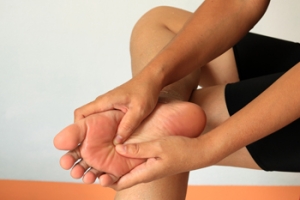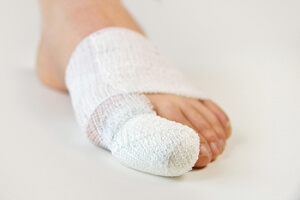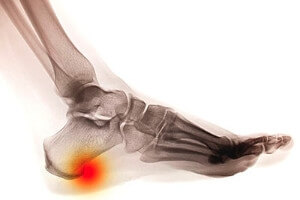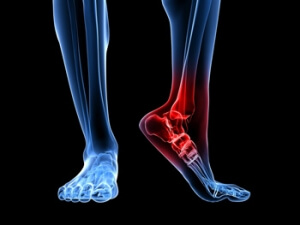BLOG

Different Types of Foot Pain
 While the feet are an important part of the body because they provide us with mobility, they are also very complicated. There any many different types of foot conditions that affect different areas of the foot, and they usually involve pain, inflammation, or injury. Shoes that do not fit properly are one of the most common causes of foot pain and can lead to different types of foot complications. Shoes that do fit well and have proper support can prevent aggravation with foot skin and joints. Some examples of common conditions that result in foot pain are heel spurs, bunions, Morton’s neuroma, hammertoes, and cuboid syndrome. Injuries such as sprains and breaks will also lead to a great deal of foot pain. If you are experiencing any foot pain, it is suggested you speak with a podiatrist to determine the issue.
While the feet are an important part of the body because they provide us with mobility, they are also very complicated. There any many different types of foot conditions that affect different areas of the foot, and they usually involve pain, inflammation, or injury. Shoes that do not fit properly are one of the most common causes of foot pain and can lead to different types of foot complications. Shoes that do fit well and have proper support can prevent aggravation with foot skin and joints. Some examples of common conditions that result in foot pain are heel spurs, bunions, Morton’s neuroma, hammertoes, and cuboid syndrome. Injuries such as sprains and breaks will also lead to a great deal of foot pain. If you are experiencing any foot pain, it is suggested you speak with a podiatrist to determine the issue.
Foot Pain
Foot pain can be extremely painful and debilitating. If you have a foot pain, consult with one of our podiatrists from Livingston Foot Care Specialists. Our doctors will assess your condition and provide you with quality foot and ankle treatment.
Causes
Foot pain is a very broad condition that could be caused by one or more ailments. The most common include:
- Bunions
- Hammertoes
- Plantar Fasciitis
- Bone Spurs
- Corns
- Tarsal Tunnel Syndrome
- Ingrown Toenails
- Arthritis (such as Gout, Rheumatoid, and Osteoarthritis)
- Flat Feet
- Injury (from stress fractures, broken toe, foot, ankle, Achilles tendon ruptures, and sprains)
- And more
Diagnosis
To figure out the cause of foot pain, podiatrists utilize several different methods. This can range from simple visual inspections and sensation tests to X-rays and MRI scans. Prior medical history, family medical history, and any recent physical traumatic events will all be taken into consideration for a proper diagnosis.
Treatment
Treatment depends upon the cause of the foot pain. Whether it is resting, staying off the foot, or having surgery; podiatrists have a number of treatment options available for foot pain.
If you have any questions, please feel free to contact our office located in North Bellmore, NY . We offer the newest diagnostic and treatment technologies for all your foot care needs.
Foot Pain
The feet, being the foundation of the body, carry all of the body’s weight and are therefore prone to experiencing pain and discomfort. If you are experiencing foot pain, it is important to determine where in the foot you are experiencing this pain to help discover the cause of it. While pain can be experienced virtually anywhere in the foot, the most common sites of foot pain are in the heel and ankle.
Heel pain can be due to a multitude of conditions including plantar fasciitis, Achilles tendinitis, and heel spurs. Pain experienced in the ankle can be a sign of an ankle sprain, arthritis, gout, ankle instability, ankle fracture, or nerve compression. In more serious cases, pain in the foot can be a sign of improper alignment or an infection.
Foot pain can be accompanied by symptoms including redness, swelling, stiffness and warmth in the affected area. Whether the pain can be described as sharp or dull depends on the foot condition behind it. It is important to visit your local podiatrist if your foot pain and its accompanying symptoms persist and do not improve over time.
Depending on the location and condition of your foot pain, your podiatrist may prescribe certain treatments. These treatments can include but are not limited to prescription or over-the-counter drugs and medications, certain therapies, cortisone injections, or surgery.
If you are experiencing persistent foot pain, it is important to consult with your foot and ankle doctor to determine the cause and location. He or she will then prescribe the best treatment for you. While milder cases of foot pain may respond well to rest and at-home treatments, more serious cases may take some time to fully recover.
Causes of Hammertoe
 The medical condition that is known as hammertoe will typically affect the second, third, or fourth toe. If you notice a downward bend in the middle joints of those toes, it may often resemble the shape of a hammer. It typically causes pain and discomfort and wearing shoes may be difficult. The causes of hammertoe may include having a genetic trait, or wearing shoes that do not have adequate room in the toe area for the toes to move freely in. Additionally, if an injury has occurred to the toes, this may be a reason for this condition to develop. The toes may be unable to bend, and surgery may be required to permanently straighten the toes. If you are noticing symptoms of hammertoe, it is advised to schedule a consultation with a podiatrist who can guide your toward proper treatment.
The medical condition that is known as hammertoe will typically affect the second, third, or fourth toe. If you notice a downward bend in the middle joints of those toes, it may often resemble the shape of a hammer. It typically causes pain and discomfort and wearing shoes may be difficult. The causes of hammertoe may include having a genetic trait, or wearing shoes that do not have adequate room in the toe area for the toes to move freely in. Additionally, if an injury has occurred to the toes, this may be a reason for this condition to develop. The toes may be unable to bend, and surgery may be required to permanently straighten the toes. If you are noticing symptoms of hammertoe, it is advised to schedule a consultation with a podiatrist who can guide your toward proper treatment.
Hammertoe
Hammertoes can be a painful condition to live with. For more information, contact one of our podiatrists from Livingston Foot Care Specialists. Our doctors will answer any of your foot- and ankle-related questions.
Hammertoe is a foot deformity that affects the joints of the second, third, fourth, or fifth toes of your feet. It is a painful foot condition in which these toes curl and arch up, which can often lead to pain when wearing footwear.
Symptoms
- Pain in the affected toes
- Development of corns or calluses due to friction
- Inflammation
- Redness
- Contracture of the toes
Causes
Genetics – People who are genetically predisposed to hammertoe are often more susceptible
Arthritis – Because arthritis affects the joints in your toes, further deformities stemming from arthritis can occur
Trauma – Direct trauma to the toes could potentially lead to hammertoe
Ill-fitting shoes – Undue pressure on the front of the toes from ill-fitting shoes can potentially lead to the development of hammertoe
Treatment
Orthotics – Custom made inserts can be used to help relieve pressure placed on the toes and therefore relieve some of the pain associated with it
Medications – Oral medications such as anti-inflammatories or NSAIDs could be used to treat the pain and inflammation hammertoes causes. Injections of corticosteroids are also sometimes used
Surgery – In more severe cases where the hammertoes have become more rigid, foot surgery is a potential option
If you have any questions please contact our office located in North Bellmore, NY . We offer the newest diagnostic and treatment technologies for all your foot and ankle needs.
What Are Hammertoes?
Hammertoes are painful deformities that frequently form on the second, third, or fourth toe. The condition is often caused by an issue in foot mechanics. This can be caused by the person’s specific gait or the manner in which they walk, or by shoes that do not comfortably fit the deformity. Hammertoes can be formed after wearing shoes that are too narrow or short for the foot or have excessively high heels. Shoes that are not properly sized will force the toes into a bent position for long periods of time. This can cause the muscles to shorten and toes to bend into the deformity of a hammertoe.
Hammertoe can also be caused by complications from rheumatoid arthritis, osteoarthritis, trauma to the foot, heredity, or a cerebral vascular accident. Pain and difficult mobility of the toes, deformities, calluses, and corns are all symptoms of a hammertoe.
Someone who suspects they have the symptoms of a hammertoe should consult with a physician—particularly a podiatrist. Podiatrists diagnose and treat complications of the foot and ankle. If the podiatrist discovers that the affected toes are still flexible, treatment for the hammertoe may simply involve exercise, physical therapy, and better-fitting shoes. Treatment for hammertoes typically involves controlling foot mechanics, such as walking, through the use of customized orthotics.
For more serious cases in which the toes have become inflexible and rigid, surgery may be suggested. During the operation, the toe would receive an incision to relieve pressure on the tendons. A re-alignment of the tendons may then be performed by removing small pieces of bone to straighten the toe. In some cases, the insertion of pins is needed to keep the bones in the proper position as the toe heals. The patient is usually allowed to return home on the same day as the surgery.
If surgery is performed to repair a hammertoe, following the postoperative directions of your doctor is essential. Directions may include several stretches, picking up marbles with your toes, or attempting to crumple a towel placed flat against your feet. Wear shoes that have low heels and a wide amount of toe space to maintain comfort. Closed-toe shoes and high heels should be avoided. Shoes with laces allow the wearer to adjust how fitted he or she may want the shoes to be and also allow for greater comfort. To provide adequate space for your toes, select shoes that have a minimum of one-half inch of space between the tip of your longest toe and the inside of the shoe. This will also relieve pressure on your toes and prevent future hammertoes from forming.
Other preventative measures that can be taken include going shopping for new shoes in the middle of the day. Your feet are its smallest in the morning and swell as the day progresses. Trying on and purchasing new shoes midday will give you the most reliable size. Be sure to check that the shoes you purchase are both the same size. If possible, ask the store to stretch out the shoes at its painful points to allow for optimum comfort.
Symptoms of a Broken Toe
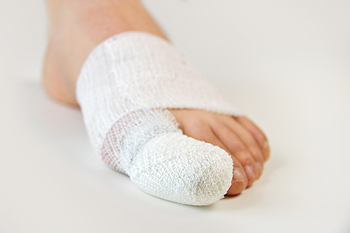 There are several ways a broken toe may occur. These may include dropping a heavy object on the toe, stubbing it on a piece of furniture, or consistent impact that can cause a stress fracture. One of the first symptoms felt may be severe pain. Many people may also notice bruising and swelling around the affected toe and surrounding areas. A cast may be needed if the fracture is severe, and the toe may look deformed. After the injury occurs, it can be beneficial to elevate the foot, and this can be helpful in reducing any swelling that may be present. Some patients find that support and stability may be increased if the affected toe is taped to the toe next to it. As the healing process begins, it is important to rest the foot as often as possible. When the splint or tape is removed, the toe's range of motion can increase as stretching exercises are performed. If you have broken your toe, it is advised that you speak to a podiatrist who can recommend the correct treatment.
There are several ways a broken toe may occur. These may include dropping a heavy object on the toe, stubbing it on a piece of furniture, or consistent impact that can cause a stress fracture. One of the first symptoms felt may be severe pain. Many people may also notice bruising and swelling around the affected toe and surrounding areas. A cast may be needed if the fracture is severe, and the toe may look deformed. After the injury occurs, it can be beneficial to elevate the foot, and this can be helpful in reducing any swelling that may be present. Some patients find that support and stability may be increased if the affected toe is taped to the toe next to it. As the healing process begins, it is important to rest the foot as often as possible. When the splint or tape is removed, the toe's range of motion can increase as stretching exercises are performed. If you have broken your toe, it is advised that you speak to a podiatrist who can recommend the correct treatment.
A broken toe can be very painful and lead to complications if not properly fixed. If you have any concerns about your feet, contact one of our podiatrists from Livingston Foot Care Specialists. Our doctors will treat your foot and ankle needs.
What to Know About a Broken Toe
Although most people try to avoid foot trauma such as banging, stubbing, or dropping heavy objects on their feet, the unfortunate fact is that it is a common occurrence. Given the fact that toes are positioned in front of the feet, they typically sustain the brunt of such trauma. When trauma occurs to a toe, the result can be a painful break (fracture).
Symptoms of a Broken Toe
- Throbbing pain
- Swelling
- Bruising on the skin and toenail
- The inability to move the toe
- Toe appears crooked or disfigured
- Tingling or numbness in the toe
Generally, it is best to stay off of the injured toe with the affected foot elevated.
Severe toe fractures may be treated with a splint, cast, and in some cases, minor surgery. Due to its position and the pressure it endures with daily activity, future complications can occur if the big toe is not properly treated.
If you have any questions please feel free to contact our office located in North Bellmore, NY . We offer the newest diagnostic and treatment technologies for all your foot and ankle needs.
Read more about What to Know About a Broken ToeWhat to Know About a Broken Toe
Trauma to the foot, especially the toes, can occur in many ways. Banging them, stubbing them, or dropping something on them are a few different ways this trauma can occur. Given the fact that toes are positioned in front of the feet, they typically sustain the brunt of such trauma. When trauma occurs to a toe, the result can be a painful break or fracture. Another type of trauma that can break a toe is repeated activity that places stress on the toe for prolonged periods of time.
Broken toes can be categorized as either minor or severe fractures. Symptoms of minor toe fractures include throbbing pain, swelling, bruising on the skin and toenail, and the inability to move the toe with ease. Severe toe fractures require medical attention and are indicated when the broken toe appears crooked or disfigured, when there is tingling or numbness in the toe, or when there is an open, bleeding wound present on the toe.
Generally, a minor toe break will heal without long-term complications. However, it is important to discontinue activities that put pressure on the toe. It is best to stay off of the injured toe and immediately get a splint or cast to prevent any more additional movement of the toe bones. You can also immobilize your toe by placing a small cotton ball between the injured toe and the toe beside it. Then, tape the two toes together with medical tape. Swelling can be alleviated by placing an ice pack on the broken toe directly as well as elevating your feet above your head.
Severe toe fractures may be treated with a splint, cast, and in some cases, minor surgery, especially when the big toe has been broken. Due to its position and the pressure the big toe endures with daily activity, future complications can occur if it is not properly treated. Pain associated with minor toe fractures can be managed with over-the-counter pain medications. Prescription pain killers may be necessary for severe toe fractures.
The healing time for a broken toe is approximately four to six weeks. In severe cases where the toe becomes infected or requires surgery, healing time can take up to eight weeks or more. While complications associated with a broken toe are immediately apparent, it is important to note that there are rare cases when additional complications, such as osteoarthritis, can develop over time. You should immediately speak with your podiatrist if you think you have broken your toe due to trauma. They will be able to diagnose the injury and recommend the appropriate treatment options.
What Is a Heel Spur?
 The symptoms of a heel spur are characterized by pain in the heel area of the foot. This is a result of a bony growth that develops between the arch of the foot and the heel. The type of discomfort that is felt may range from a dull ache to a sharp pain, in addition to swelling and tenderness. Heel spurs may be caused by disintegration of the soft tissues that are located in the heel. The heel pads may become thinner as a result of the aging process and may not provide adequate support that is needed for shock absorption. This condition may develop from frequently participating in running and jumping activities, and this may possibly cause the heel pads to gradually diminish. Additional factors, which may include obesity and wearing poorly fitting shoes may contribute to the onset of heel spurs. If you are experiencing heel pain, it is advised to seek the counsel of a podiatrist who can properly diagnosis and treat this condition.
The symptoms of a heel spur are characterized by pain in the heel area of the foot. This is a result of a bony growth that develops between the arch of the foot and the heel. The type of discomfort that is felt may range from a dull ache to a sharp pain, in addition to swelling and tenderness. Heel spurs may be caused by disintegration of the soft tissues that are located in the heel. The heel pads may become thinner as a result of the aging process and may not provide adequate support that is needed for shock absorption. This condition may develop from frequently participating in running and jumping activities, and this may possibly cause the heel pads to gradually diminish. Additional factors, which may include obesity and wearing poorly fitting shoes may contribute to the onset of heel spurs. If you are experiencing heel pain, it is advised to seek the counsel of a podiatrist who can properly diagnosis and treat this condition.
Heel spurs can be incredibly painful and sometimes may make you unable to participate in physical activities. To get medical care for your heel spurs, contact one of our podiatrists from Livingston Foot Care Specialists. Our doctors will do everything possible to treat your condition.
Heels Spurs
Heel spurs are formed by calcium deposits on the back of the foot where the heel is. This can also be caused by small fragments of bone breaking off one section of the foot, attaching onto the back of the foot. Heel spurs can also be bone growth on the back of the foot and may grow in the direction of the arch of the foot.
Older individuals usually suffer from heel spurs and pain sometimes intensifies with age. One of the main condition's spurs are related to is plantar fasciitis.
Pain
The pain associated with spurs is often because of weight placed on the feet. When someone is walking, their entire weight is concentrated on the feet. Bone spurs then have the tendency to affect other bones and tissues around the foot. As the pain continues, the feet will become tender and sensitive over time.
Treatments
There are many ways to treat heel spurs. If one is suffering from heel spurs in conjunction with pain, there are several methods for healing. Medication, surgery, and herbal care are some options.
If you have any questions feel free to contact our office located in North Bellmore, NY . We offer the latest in diagnostic and treatment technology to meet your needs.
How to Treat Heel Spurs
Heel spurs are calcium deposits that cause bone protrusions on the heel bone. Heel spurs are usually associated with plantar fasciitis, which occurs when the plantar fasciitis in the foot becomes inflamed. Typically, heel spurs don’t cause any symptoms. However, they can produce chronic or intermittent heel pain. Those who have had the condition often describe the irritation as a stabbing pain.
There are risk factors that may make you more likely to develop heel spurs. People who have abnormal walking gaits, run and jog on hard surfaces, are obese, or wear poorly fitting shoes are more likely to develop heel spurs.
Fortunately, there are precautions you can take to avoid developing heel spurs. One of the best ways to do this is by wearing well-fitting shoes with shock-absorbent soles. Another preventative technique is to choose running shoes if you plan on running, and walking shoes if you plan on walking. Shoes are made for different activities and it is important to research a shoe before you purchase a pair.
The pain associated with heel spurs often decreases the more you walk. However, a recurrence of pain after an extended period of rest or walking is likely to occur with this condition. Those with severe heel spur pain may opt to go the surgical route for treatment. However, more than 90% of those with the condition get better without surgical treatment. If you have a heel spur and want to know if surgery is right for you, you should go to your podiatrist and he or she will be able to conduct a pre-surgical test or exam to determine if you are an optimal candidate for surgery.
Types of Foot Pain
 Many people experience heel pain at some point in their lives. Research has indicated that the most common form of heel pain is known as plantar fasciitis. This condition develops when the tendon that connects the heel to the toes becomes inflamed and irritated. Possible causes for this may be flat feet or if the arch is exceptionally high. Sever’s disease is a foot condition that may be experienced by teenagers who frequently participate in sporting activities. When this occurs, trauma is inflicted in the growth plate of the heel bone and may result in pain and discomfort. The Achilles tendon connects the heel bone to the calf muscles, and if this should become torn, pain is generally felt in the heel of the foot. If you are experiencing any type of foot pain, it is strongly suggested that you consult with a podiatrist who can properly diagnosis and treat your foot condition.
Many people experience heel pain at some point in their lives. Research has indicated that the most common form of heel pain is known as plantar fasciitis. This condition develops when the tendon that connects the heel to the toes becomes inflamed and irritated. Possible causes for this may be flat feet or if the arch is exceptionally high. Sever’s disease is a foot condition that may be experienced by teenagers who frequently participate in sporting activities. When this occurs, trauma is inflicted in the growth plate of the heel bone and may result in pain and discomfort. The Achilles tendon connects the heel bone to the calf muscles, and if this should become torn, pain is generally felt in the heel of the foot. If you are experiencing any type of foot pain, it is strongly suggested that you consult with a podiatrist who can properly diagnosis and treat your foot condition.
Many people suffer from bouts of heel pain. For more information, contact one of our podiatrists of Livingston Foot Care Specialists. Our doctors can provide the care you need to keep you pain-free and on your feet.
Causes of Heel Pain
Heel pain is often associated with plantar fasciitis. The plantar fascia is a band of tissues that extends along the bottom of the foot. A rip or tear in this ligament can cause inflammation of the tissue.
Achilles tendonitis is another cause of heel pain. Inflammation of the Achilles tendon will cause pain from fractures and muscle tearing. Lack of flexibility is also another symptom.
Heel spurs are another cause of pain. When the tissues of the plantar fascia undergo a great deal of stress, it can lead to ligament separation from the heel bone, causing heel spurs.
Why Might Heel Pain Occur?
- Wearing ill-fitting shoes
- Wearing non-supportive shoes
- Weight change
- Excessive running
Treatments
Heel pain should be treated as soon as possible for immediate results. Keeping your feet in a stress-free environment will help. If you suffer from Achilles tendonitis or plantar fasciitis, applying ice will reduce the swelling. Stretching before an exercise like running will help the muscles. Using all these tips will help make heel pain a condition of the past.
If you have any questions please contact our office located in North Bellmore, NY . We offer the newest diagnostic and treatment technologies for all your foot and ankle needs.
Read more about Heel PainHeel Pain
Have you ever gotten up from a chair or out of bed in the morning, and upon taking that first step, feel like your heel has stepped on a tack? Many people experience a feeling of sharp pain which radiates into their arch from their heel and which does not allow them to put their heel on the floor. Sometimes they need to sit back down, stand only on their toes and use the wall for balance. If you can take a few steps, it seems to go away and lessen, allowing you to then resume your activity. Later, throughout your day and after a period of rest, it can happen again. If this sounds familiar you may be suffering from your first attack of heel pain.
Heel pain is a debilitating condition that affects day to day activities. Running and walking both causes stress on the heel because the heel is the part of the foot that hits the ground first. This means that the heel is taking on your entire weight. Diagnosis and treatments for heel pain can be easily found through your podiatrist.
Plantar Fasciitis
One of the main causes of heel pain is a condition known as plantar fasciitis. The plantar fascia is a band of tissue that extends along the bottom of the foot, from the toe to the bottom of the heel. A rip or tear in this ligament can cause inflammation of these tissues, resulting in heel pain. People who do not wear proper fitting shoes are often at risk of developing problems such as plantar fasciitis. Unnecessary stress from ill-fitting shoes, weight change, excessive running, and wearing non-supportive shoes on hard surfaces are all causes of plantar fasciitis.
Achilles Tendonitis
Achilles tendonitis is another cause of heel pain. Similar to plantar fasciitis, inflammation of the Achilles tendon will cause heel pain due to stress fractures and muscle tearing. A lack of flexibility of the ankle and heel is an indicator of Achilles tendonitis. If left untreated, this condition can lead to plantar fasciitis and cause even more pain on your heel.
Heel Spur
A third cause of heel pain is a heel spur. A heel spur occurs when the tissues of the plantar fascia undergo a great deal of stress, leading to a separation of the ligament from the heel bone entirely. This results in a pointed fragment of bone on the ball of the foot, known as a heel spur.
